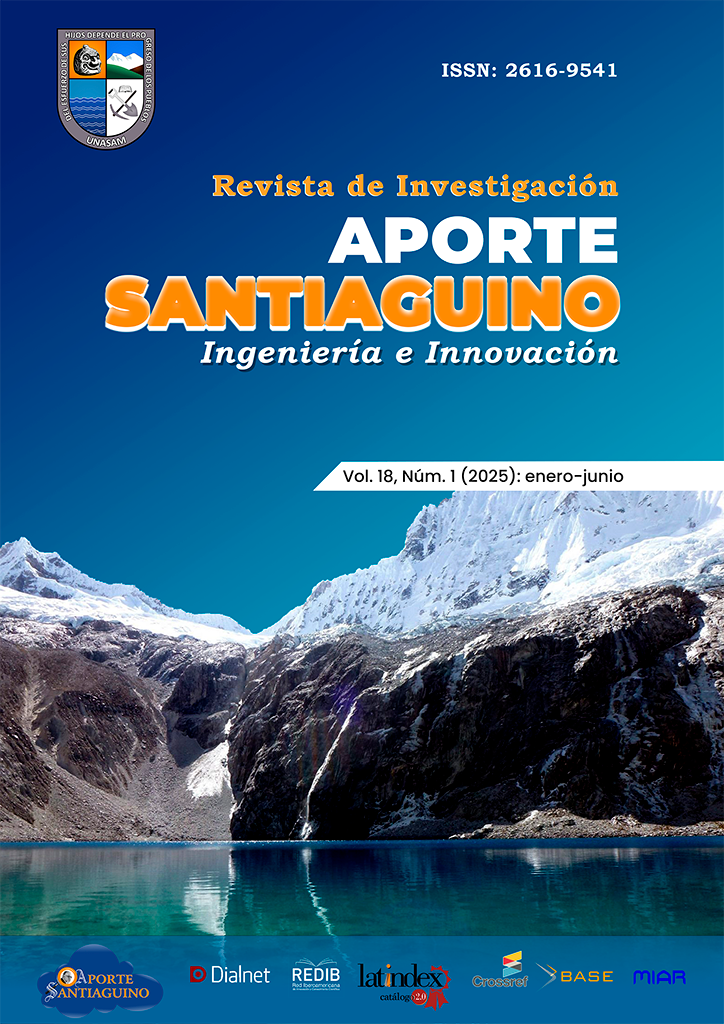Vorticidad y socavación fluvial alrededor de las estructuras hidráulicas : una revisión
DOI:
https://doi.org/10.32911/as.2025.v18.n1.1226Palabras clave:
Vorticidad, Socavación, Espigones, Advección, Estiramiento, Difusión, Número de StrouhalResumen
El objetivo principal fue analizar la vorticidad como fenómeno hidráulico, que influye en la socavación fluvial alrededor de las estructuras hidráulicas. La metodología consistió en la revisión de bibliografía y de artículos científicos relacionados a la vorticidad y su efecto en la socavación. Una de las conclusiones relevantes es que la deducción de la ecuación de la vorticidad se realiza a partir de la ecuación de Navier-Stokes, la misma que contiene los términos de advección y la tasa de cambio de la vorticidad local en el primer miembro; mientras que el segundo miembro contiene los términos de estiramiento y difusión de la vorticidad. La advección de la vorticidad consiste en el transporte de la vorticidad a lo largo del río, que contribuye a la socavación general pero más en la socavación local. El estiramiento de la vorticidad representa la intensificación de la vorticidad en la dirección de la velocidad del flujo, que contribuye a la socavación local y la difusión de la vorticidad que expresa la atenuación de la vorticidad. Detrás de los pilares de los puentes se generan desprendimiento de vórtices de estela, que se evalúan a través del número de Strouhal.
Descargas
Citas
Adnan, M., Zhao, M., Wu, H., & Dhamelia, V. (2025). Experimental study of local scour around a compound pile under steady current. Ocean Engineering, 318, 120151. https://doi.org/10.1016/j.oceaneng.2024.120151
Al-Jubouri, M., & Ray, R. (2023). A comparative study of local scour depth around bridge piers. Pollack Periodica, 18(1), 100–105. https://doi.org/10.1556/606.2022.00649
Baranwal, A., & Das, B. (2024). Scouring around bridge pier: A comprehensive review of countermeasure techniques. Engineering Research Express, 6(022103). https://doi.org/10.1088/2631-8695/ad5495.
Bourguet, R., Modarres-Sadeghi, Y., Karniadakis, G. E., & Triantafyllou, M. S. (2011). Wake-body resonance of long flexible structures is dominated by counterclockwise orbits. Physical review letters,107(13), 134502. https://doi.org/10.1103/PhysRevLett.107.134502
Cengel, Y., & Cimbala, J. (2014). Fluid mechanics. McGraw – Hill.
Budhu, M. (2007). Soil mechanics and foundations. John Wiley & Sons.
Chanson, H. (2009). Applied hydrodynamics: an introduction to ideal and real fluid flows. CRC press.
Chen, Q., Yang, Z., & Wu, H. (2019). Evolution of turbulent horseshoe vortex system in front of a vertical circular cylinder in open channel. Water, 11(10), 2079. https://doi.org/10.3390/w11102079
Chen, Z., Zhou, J., & Chen, Q. (2023). Research and Application of the Calculation Method of River Roughness Coefficient with Vegetation. Water, 15(7), https://doi.org/10.3390/w15142638
Choufu, L., Abbasi, S., Pourshahbaz, H., Taghvaei, P., & Tfwala, S. (2019). Investigation of flow, erosion, and sedimentation pattern around varied groynes under different hydraulic and geometric conditions: A numerical study. Water, 11(2), 235. https://doi.org/10.3390/w11020235
Dey, S., Raikar, R. V., & Roy, A. (2008). Scour at submerged cylindrical obstacles under steady flow. Journal of Hydraulic Engineering, 134(1), 105-109. https://doi.org/10.1061/(ASCE)0733-9429(2008)134:1(105)
Echeverribar, I., Morales-Hernández, M., Lacasta, A., Brufrau, P., & García-Navarro, P. (2017). Simulación numérica con RiverFlow2D de posibles soluciones de mitigación de avenidas en el tramo medio del río Ebro. Ingeniería del agua, 21(1), 53-70. https://doi.org/10.4995/ia.2017.6550
Fay, J. (1996). Mecánica de fluidos. México: Compañía Editorial Continental, S.A.
Hirst, C., McDonald, N. (2024). Erosion of surfaces by trapped vortices. Journal of Engineering Mathematics, 148(7). https://doi.org/10.1007/s10665-024-10396-6
Khan, Z., Khan, D., Murtaza, N., Pasha, G., Alotaibi, S., Rezzoug, A., Benzougagh, B., & Khedher, K. (2024). Advanced prediction models for scouring around bridge abutments: A comparative study of empirical and AI techniques. Water, 16(3082). https://doi.org/10.3390/w16213082
Koken, M., Gogus, M. (2010). Time evolution of the horseshoe vortex system forming around a bridge abutment. In S. E. Burns, S. K.
Bhatia, C. M. C. Avila, & B. E. Hunt (Eds.), Proceedings of the 5th International Conference on Scour and Erosion (ICSE-5), November 7-10, 2010, San Francisco, USA (pp. 668-677). American Society of Civil Engineers. https://hdl.handle.net/20.500.11970/100281
Kumcu, S., Kokpinar, M., & Gogus, M. (2014). Scour protection around vertical-wall bridge abutments with collars. KSCE Journal of Civil Engineering, 18(6), 1884-1895. https://doi.org/10.1007/s12205-014-0245-4
Maeda, J., & Fukui, T. (2025). Numerical study of suspension viscosity accounting for particle–fluid interactions under low-confinement conditions in two-dimensional parallel-plate flow. Processes, 13(690). https://doi.org/10.3390/pr13030690
Marsden, J., Tromba, A. (2012). Vector calculus. Freeman and Company Publishers.
Melville, B. (2008). The physics of local scour at bridge piers. In H. Sekiguchi (Ed.), Proceedings of the 4th International Conference on Scour and Erosion (ICSE-4) (pp. 28-40). The Japanese Geotechnical Society. https://hdl.handle.net/20.500.11970/100095
Mohamed, W. (2020). Effect of local scour on foundation of hydraulic structure. International Research Journal of Engineering and Technology (IRJET), 7(2), 916-924. https://www.irjet.net
Liao, C., Yeh, K., Lan, Y., Jhong, R., & Jia, Y. (2021). Improving the 2d numerical simulations on local scour hole around spur dikes. Water, 13(11), https://doi.org/10.3390/w13111462.
Omara, H., Tawfik, A. (2018). Numerical study of local scour around bridge piers. IOP Conference Series: Earth and Environmental Science, 151(012013). https://doi.org/10.1088/1755-1315/151/1/012013
Paik, J., Bombardelli, F., & Lee, N. (2014). Numerical simulation of turbulent free surface flow around a circular cylinder. In Lehfeldt & Kopmann (Eds.), Proceedings of the International Conference on Hydro-Science & Engineering (ICHE 2014) (pp. 991-999). Bundesanstalt für Wasserbau. ISBN 978-3-939230-32-8.
Pizarro, S., Manfreda, S., Tubaldi, E. (2020). The science behind scour and bridge foundation: a review. Water, 12(374). https://acortar.link/qtqSO4
Potter, M., & Wiggert, D. (2012). Mechanics of fluids. Cengage Learning.
Rodríguez, B., & Escauriaza, C. (2010). Turbulent flow in the scour hole downstream of a sluice gate: erosion induced by Görtler vortices. En Dittrich, A.; Koll, K.; Aberle, J.; Geisenhainer, P. (Eds.), River Flow, Karlsruhe: Bundesanstalt für Wasserbau, pp. 195-202. https://hdl.handle.net/20.500.11970/99646.
Rossi, E., Colagrossi, A., & Graziani, G. (2015). Numerical simulation of 2D-vorticity dynamics using particle methods. Computers and Mathematics with Applications, 69(12), 1484-1503. https://doi.org/10.1016/j.camwa.2015.04.004
Saha, R., Lee, S., Hong, S. (2018). A comprehensive method of calculating maximum bridge scour depth. Water, 10(11), 1572. https://doi.org/10.3390/w10111572
Wang, W., Wei, S., Zhu, D., Wang, J., & Duan, H. (2024). Characteristics and mechanism of downflow in front of a cylindrical pier with clear-water local scour. Water, 16(1863). https://doi.org/10.3390/w16131863:contentReference[oaicite:0]{index=0}.
White, F. (2016). Mechanics of fluids. McGraw – Hill Education
Unger, J., & Hager, W. (2007). Downflow and horseshoe vortex characteristics of sediment embedded bridge piers. Experiments in Fluids, 42(1), 1–19. https://doi.org/10.1007/s00348-006-0209-7
Wu, J. Z., Ma, H. Y., Zhou, M. D., Wu, J. Z., Ma, H. Y., & Zhou, M. D. (2006). Typical vortex solutions. Vorticity and Vortex Dynamics, 255-321. https://doi.org/10.1007/978-3-540-29028-5_6
Yousif, A., Sulaiman, S., Diop, L., Ehteram, M., Shahid, S., Al-Ansari, N., Yaseen, Z. (2019). Open channel sluice gate scouring parameters prediction: Different scenarios of dimensional and non-dimensional input parameters. Water, 11(2), 353. https://doi.org/10.3390/w11020353
Zaid, M., Yazdanfar, Z., Chowdhury, H., Alam, F. (2019). A review on the methods used to reduce the scouring effect of bridge pier. Energy Procedia, 160, 45–50. https://doi.org/10.1016/j.egypro.2019.02.117
Publicado
Cómo citar
Número
Sección
Licencia
Derechos de autor 2025 Toribio Reyes Rodríguez, Maximiliano Asís-López

Esta obra está bajo una licencia internacional Creative Commons Atribución 4.0.





















